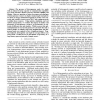Free Online Productivity Tools
i2Speak
i2Symbol
i2OCR
iTex2Img
iWeb2Print
iWeb2Shot
i2Type
iPdf2Split
iPdf2Merge
i2Bopomofo
i2Arabic
i2Style
i2Image
i2PDF
iLatex2Rtf
Sci2ools
INFOCOM
2005
IEEE
2005
IEEE
Exploiting heterogeneity in sensor networks
—The presence of heterogeneous nodes (i.e., nodes with an enhanced energy capacity or communication capability) in a sensor network is known to increase network reliability and lifetime. However, questions of where, how many, and what types of heterogeneous resources to deploy remain largely unexplored. We focus on energy and link heterogeneity in ad hoc sensor networks and consider resource-aware MAC and routing protocols to utilize those resources. Using analysis, simulation, and real testbed measurements, we evaluate the impact of number and placement of heterogeneous resources on performance in networks of different sizes and densities. While we prove that optimal deployment is very hard in general, we also show that only a modest number of reliable, long-range backhaul links and linepowered nodes are required to have a significant impact. Properly deployed, heterogeneity can triple the average delivery rate and provide a 5-fold increase in the lifetime (respectively) of a large ...
| Added | 25 Jun 2010 |
| Updated | 25 Jun 2010 |
| Type | Conference |
| Year | 2005 |
| Where | INFOCOM |
| Authors | Mark D. Yarvis, Nandakishore Kushalnagar, Harkirat Singh, Anand Rangarajan, York Liu, Suresh Singh |
Comments (0)

